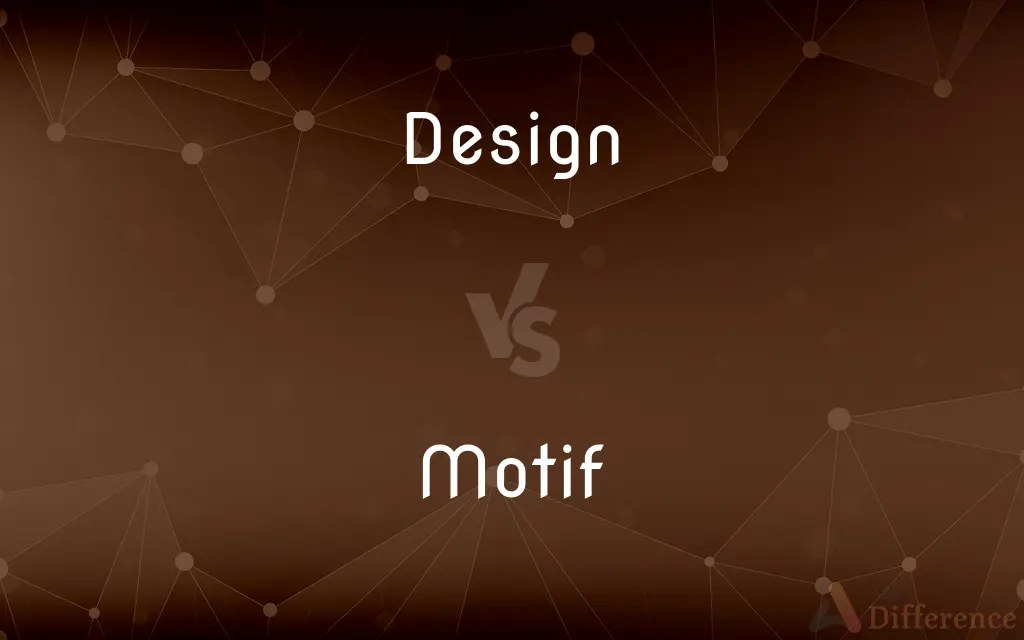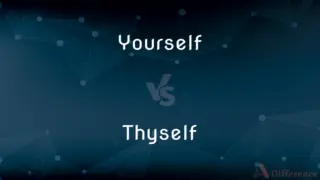Design vs. Motif — What's the Difference?
By Tayyaba Rehman & Maham Liaqat — Updated on April 25, 2024
Design refers to a broad plan or structure for creating something, while a motif is a recurring theme or element within a design.

Difference Between Design and Motif
Table of Contents
ADVERTISEMENT
Key Differences
Design encompasses the overall plan or blueprint for constructing an object or system, focusing on functionality, aesthetics, and usability. On the other hand, a motif is a specific element that repeats throughout a design, often to create thematic consistency or enhance aesthetic appeal.
In the realm of art, a design outlines the composition and structure of the entire piece, guiding the artist's decisions. Whereas, motifs within that design may include recurring shapes, colors, or symbols that contribute to the artwork's deeper meaning or visual harmony.
In architecture, the design involves the schematic and structural decisions that define the building's form and function. Meanwhile, architectural motifs, such as arches or geometric patterns, repeat to unify the aesthetic or to adhere to a particular style.
In fashion, designers create comprehensive plans for garments that detail everything from silhouette to materials. Conversely, motifs in fashion might manifest as repeated decorative patterns or distinctive elements like buttons or embroidery that define a brand's signature style.
In literature, the design of a story includes its plot structure and character development arcs. In contrast, literary motifs are recurring elements or themes that may appear throughout a narrative to underscore certain philosophical points or enhance the storytelling.
ADVERTISEMENT
Comparison Chart
Definition
Overall plan or blueprint of a project
A recurring element or theme
Focus
Functionality, aesthetics, usability
Thematic consistency, aesthetic appeal
Usage in Art
Guides composition and structure
Recurring shapes, colors, symbols
Usage in Architecture
Structural decisions, form of building
Repeated architectural elements
Usage in Literature
Plot structure, character arcs
Recurring themes or elements in a story
Compare with Definitions
Design
A plan or drawing produced to show the look and function of a building before it is built.
The architect unveiled the design for the new museum.
Motif
A distinctive feature or dominant idea in an artistic or literary composition.
The motif of redemption recurs throughout his novels.
Design
The art or action of conceiving of and producing a plan or drawing.
Good design integrates beauty and functionality.
Motif
A recognizable and often repeated symbol or theme.
The dove is a motif that symbolizes peace in various cultures.
Design
An arrangement of lines or shapes created to form a pattern or decoration.
The fabric featured a complex geometric design.
Motif
A decorative image or design, especially a repeated one forming a pattern.
The wallpaper featured a leaf motif.
Design
A purpose, planning, or intention behind an action or material object.
The design of the study was to measure the impact of sleep on health.
Motif
A short succession of notes producing a single impression; a brief melody.
The symphony introduced a haunting motif in its second movement.
Design
To decide upon the look and functioning of (a building, garment, or other object).
She designed a dress that reflected her unique style.
Motif
A recurring subject, theme, idea, etc., especially in a literary, artistic, or musical work.
The motif of forbidden love is explored in many classic plays.
Design
A design is a plan or specification for the construction of an object or system or for the implementation of an activity or process, or the result of that plan or specification in the form of a prototype, product or process. The verb to design expresses the process of developing a design.
Motif
A recurrent thematic element in an artistic or literary work.
Design
A plan or drawing produced to show the look and function or workings of a building, garment, or other object before it is made
He has just unveiled his design for the new museum
Motif
A dominant theme or central idea.
Design
A decorative pattern
Pottery with a lovely blue and white design
Motif
(Music) A short rhythmic or melodic passage that is repeated or evoked in various parts of a composition.
Design
Purpose or planning that exists behind an action, fact, or object
The appearance of design in the universe
Motif
A repeated figure or design in architecture or decoration.
Design
Decide upon the look and functioning of (a building, garment, or other object), by making a detailed drawing of it
A number of architectural students were designing a factory
Motif
A recurrent pattern either of molecular sequence, usually of nucleotides or amino acids in proteins, or of molecular structure that usually corresponds to specific biological activity.
Design
To conceive or fashion in the mind; invent
Design a good excuse for not attending the conference.
Motif
A recurring or dominant element; an artistic theme.
See how the artist repeats the scroll motif throughout the work?
Design
To formulate a plan for; devise
Designed a marketing strategy for the new product.
Motif
(music) A short melodic or lyrical passage that is repeated in several parts of a work.
Design
To make a graphic or schematic representation of (something), especially as a plan for its structure
Design a building on a computer.
Design a new car model.
Motif
A decorative figure that is repeated in a design or pattern.
Design
To create or contrive for a particular purpose or effect
A game designed to appeal to all ages.
Motif
(dressmaking) A decorative appliqué design or figure, as of lace or velvet, used in trimming.
Design
To have as a goal or purpose; intend
"Mrs. Bennet had designed to keep the two Netherfield gentlemen to supper.
But ... she had no opportunity of detaining them" (Jane Austen).
Motif
(crystallography) The physical object or objects repeated at each point of a lattice. Usually atoms or molecules.
Design
To make or execute plans.
Motif
(chess) A basic element of a move in terms of why the piece moves and how it supports the fulfilment of a stipulation.
Design
To create designs.
Motif
(biochemistry) In a nucleotide or aminoacid sequence, pattern that is widespread and has, or is conjectured to have, a biological significance.
Design
A drawing or sketch.
Motif
Motive.
Design
A graphic representation, especially a detailed plan for construction or manufacture.
Motif
In literature and the fine arts, a salient feature or element of a composition or work; esp., the theme, or central or dominant feature;
This motif, of old things lost, is a favorite one for the serious ballade.
The design . . . is . . . based on the peacock - a motif favored by decorative artists of all ages.
Design
An ornamental pattern.
Motif
A decorative appliqué design or figure, as of lace or velvet, used in trimming; also, a repeated design.
Design
The purposeful or inventive arrangement of parts or details
The aerodynamic design of an automobile.
The design of an epic poem.
Motif
A design that consists of recurring shapes or colors
Design
A particular plan or method
The party's design for increasing voter turnout.
Motif
A theme that is elaborated on in a piece of music
Design
The art or practice of designing or making designs
Studied design in college.
Motif
A unifying idea that is a recurrent element in a literary or artistic work;
It was the usual `boy gets girl' theme
Design
A reasoned purpose; an intent
It was her design to set up practice on her own as soon as she was qualified.
Design
Deliberate intention
He became a photographer more by accident than by design.
Design
Often designs A secretive or underhanded plot or scheme
He has designs on my job.
Design
A specification of an object or process, referring to requirements to be satisfied and thus conditions to be met for them to solve a problem.
Design
A plan (with more or less detail) for the structure and functions of an artifact, building or system.
The initial design of the park was rejected for being too expensive.
Design
A pattern, as an element of a work of art or architecture.
We're working on some new designs for our range of summer shirts
Design
The composition of a work of art.
Design
Intention or plot.
We have designs on winning the league next season.
To be hateful of the truth by design.
Design
(particularly) Malicious or malevolent intention.
To have evil designs.
Design
The shape or appearance given to an object, especially one that is intended to make it more attractive.
Design
The art of designing
Danish furniture design is world-famous.
Design
(transitive) To plan and carry out (a picture, work of art, construction etc.).
Design
To plan (to do something).
The king designed to mount an expedition to the New World.
Design
To assign, appoint (something to someone); to designate.
Design
To mark out and exhibit; to designate; to indicate; to show; to point out; to appoint.
Design
To manifest requirements to be satisfied by an object or process for them to solve a problem.
Design
To draw preliminary outline or main features of; to sketch for a pattern or model; to delineate; to trace out; to draw.
Design
To mark out and exhibit; to designate; to indicate; to show; to point out; to appoint.
We shall seeJustice design the victor's chivalry.
Meet me to-morrow where the masterAnd this fraternity shall design.
Design
To create or produce, as a work of art; to form a plan or scheme of; to form in idea; to invent; to project; to lay out in the mind; as, a man designs an essay, a poem, a statue, or a cathedral.
Design
To intend or purpose; - usually with for before the remote object, but sometimes with to.
Ask of politicians the end for which laws were originally designed.
He was designed to the study of the law.
Design
To form a design or designs; to plan.
Design
A preliminary sketch; an outline or pattern of the main features of something to be executed, as of a picture, a building, or a decoration; a delineation; a plan.
Design
A plan or scheme formed in the mind of something to be done; preliminary conception; idea intended to be expressed in a visible form or carried into action; intention; purpose; - often used in a bad sense for evil intention or purpose; scheme; plot.
The vast design and purpos of the King.
The leaders of that assembly who withstood the designs of a besotted woman.
A . . . settled design upon another man's life.
How little he could guess the secret designs of the court!
Design
Specifically, intention or purpose as revealed or inferred from the adaptation of means to an end; as, the argument from design.
Design
The realization of an inventive or decorative plan; esp., a work of decorative art considered as a new creation; conception or plan shown in completed work; as, this carved panel is a fine design, or of a fine design.
Design
The invention and conduct of the subject; the disposition of every part, and the general order of the whole.
Is he a prudent man . . . that lays designs only for a day, without any prospect to the remaining part of his life?
I wish others the same intention, and greater successes.
It is the purpose that makes strong the vow.
Design
The act of working out the form of something (as by making a sketch or outline or plan);
He contributed to the design of a new instrument
Design
An arrangement scheme;
The awkward design of the keyboard made operation difficult
It was an excellent design for living
A plan for seating guests
Design
Something intended as a guide for making something else;
A blueprint for a house
A pattern for a skirt
Design
A decorative or artistic work;
The coach had a design on the doors
Design
An anticipated outcome that is intended or that guides your planned actions;
His intent was to provide a new translation
Good intentions are not enough
It was created with the conscious aim of answering immediate needs
He made no secret of his designs
Design
A preliminary sketch indicating the plan for something;
The design of a building
Design
The creation of something in the mind
Design
Make or work out a plan for; devise;
They contrived to murder their boss
Design a new sales strategy
Plan an attack
Design
Design something for a specific role or purpose or effect;
This room is not designed for work
Design
Create the design for; create or execute in an artistic or highly skilled manner;
Chanel designed the famous suit
Design
Make a design of; plan out in systematic, often graphic form;
Design a better mousetrap
Plan the new wing of the museum
Design
Create designs;
Dupont designs for the house of Chanel
Design
Conceive or fashion in the mind; invent;
She designed a good excuse for not attending classes that day
Design
Intend or have as a purpose;
She designed to go far in the world of business
Common Curiosities
Can a motif influence the overall design?
Yes, motifs can significantly influence the aesthetic and thematic aspects of a design by providing a cohesive element that ties various parts of the design together.
Is a motif necessary in every design?
Not necessarily; while motifs can enhance a design's appeal and coherence, they are not mandatory in every design.
How does a motif differ from a design?
A motif is a specific, often decorative element that recurs within a design to create thematic consistency or visual appeal, unlike the broader concept of a design.
Are motifs always visual?
No, motifs can also be auditory, such as a recurring melody in music, or conceptual, like a recurring theme in a story.
What differentiates a motif from a pattern?
A motif is a single element or theme that repeats, while a pattern is a systematic arrangement and repetition of multiple elements, often including motifs.
What is the main purpose of a design?
The main purpose of a design is to outline a plan or structure for building or creating something, focusing on practicality, aesthetics, and function.
Can motifs change over time within a design?
Yes, motifs can evolve or be altered over time in a design, especially in response to trends, cultural shifts, or innovations.
How can motifs be identified in art?
In art, motifs can often be identified as recurring symbols, colors, or shapes that contribute to the overall theme or message of the artwork.
How do designers choose motifs?
Designers often choose motifs based on the cultural, historical, and thematic relevance to the project, as well as their visual appeal and harmony with the overall design.
Can a design exist without any motifs?
Yes, a design can exist without motifs, especially in minimalist or highly functional designs where simplicity and utility are prioritized over decorative elements.
Can motifs be functional as well as decorative?
Yes, motifs can be both functional and decorative, especially when they play a role in guiding user interaction or enhancing usability in product design.
How do motifs enhance storytelling in literature?
Motifs in literature help to enhance storytelling by reinforcing themes and enriching the narrative through the repetition of symbolic elements or ideas.
What is an example of a common motif in architecture?
A common architectural motif is the use of columns, which can be seen in classical, Renaissance, and neoclassical structures.
How important are motifs in graphic design?
Motifs are crucial in graphic design as they help establish visual identity and continuity, making brand materials recognizable and cohesive.
What role do motifs play in fashion design?
In fashion design, motifs serve as recurring decorative elements that can define a brand's identity or the unique style of a collection.
How do motifs contribute to the user experience in digital design?
In digital design, motifs can enhance the user experience by creating a visually consistent and intuitive interface that aligns with the digital product’s branding and functionality.
What impact do motifs have on consumer perception?
Motifs can significantly impact consumer perception by creating a sense of brand recognition and emotional resonance, often influencing purchasing decisions.
What is the difference between a motif and a symbol?
A motif is a recurring element that has thematic significance within a specific context, whereas a symbol generally has a broader and more universally recognized meaning.
Share Your Discovery

Previous Comparison
Sleek vs. Slick
Next Comparison
Yourself vs. ThyselfAuthor Spotlight
Written by
Tayyaba RehmanTayyaba Rehman is a distinguished writer, currently serving as a primary contributor to askdifference.com. As a researcher in semantics and etymology, Tayyaba's passion for the complexity of languages and their distinctions has found a perfect home on the platform. Tayyaba delves into the intricacies of language, distinguishing between commonly confused words and phrases, thereby providing clarity for readers worldwide.
Co-written by
Maham Liaqat















































